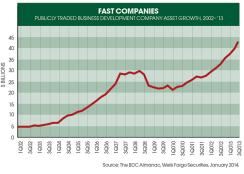Business development companies, which invest mostly in U.S. private corporations, are the new real estate investment trusts. Like REITs or mutual funds, BDCs are simply legal structures to hold securities. Although REITs, which sprang up in the 1970s to give individuals access to commercial real estate, have become mainstream, BDCs are in their infancy, but they’re growing quickly.
Individual investors looking for higher-yielding, if riskier, investments in a world of historically low rates are fueling the growth of BDCs, many of which offer direct secured lending to midsize companies. BDCs are also gaining prominence as individuals seek access to alternatives like credit hedge funds that have long been the playground of big institutions. Today the U.S. is home to 43 traded and 11 nontraded BDCs, representing $56.5 billion in total assets, according to BDC operator Franklin Square Capital Partners; in 2000 there were just three, with a combined $2.2 billion in assets.
BDCs — the first of which was launched in 1991 by Los Angeles–based Allied Capital to stimulate investments in undercapitalized companies — also present a big opportunity for money managers with expertise in high-yield and leveraged loans; thanks to stricter regulations since the financial crisis, banks no longer make many loans to riskier smaller and midsize companies. They’re an alternative to mezzanine funds too. BDCs are picking up the slack, explains Vincent Lima, managing director of capital markets advisory at New York–based independent investment bank Moelis & Co. Lima, who raises money for middle-market companies, says BDCs also give money managers permanent capital because, as loans mature, principal is recycled into new investments and dividends are paid to investors. By contrast, private equity–style funds have a limited life and force managers to constantly raise funds from new investors.
Last April, Goldman Sachs Group launched a BDC called Liberty Harbor Capital; Philadelphia-based Franklin Square, the largest operator of BDCs globally, with $9 billion in assets, expects to bring a fourth to market in March. Apollo Global Management, Carlyle Group and TPG Capital are some other big names in the space, but observers say every manager with experience with non-investment-grade credit is thinking about making a move there.

Franklin Square’s offerings are all subadvised by New York–based GSO Capital, the institutional-credit manager of publicly traded, $248 billion investment giant Blackstone Group. Under the deal GSO gets access to retail distribution from Franklin Square, while Franklin Square gets a big prestige name from the institutional market. GSO recommends potential investments, and Franklin Square takes another look at the deals before they’re finalized. In addition, Franklin Square manages the portfolio and handles the labor-intensive process of distributing products to retail investors.
Zachary Klehr, executive vice president of product for Franklin Square, says leveraged loans are attractive because their floating rates help guard against interest rate risk. He points out that the funds conduct double due diligence to protect investors, first through GSO, then through Franklin Square. “Investors can spend 30 to 45 days of diligence in underwriting loans,” Moelis’s Lima notes, adding that middle-market loans don’t have a natural secondary market and liquidity is sparse: “These loans are underwritten to hold to maturity.”
BDCs are often criticized for their illiquidity, but that’s why they can offer higher returns: They’re dealing in highly illiquid parts of the markets where borrowers pay higher rates for capital. If a company can no longer service its loans, though, the BDC typically has few, if any, willing buyers for such a small issue. BDCs also get flak for their high fees, which often consist of a 2 percent management fee and 20 percent of profits. Klehr emphasizes that the 2-and-20 structure is common in the institutional world but says Franklin Square always shows its returns net of fees. For the three years ended last September 30, FS Investment Corp., the firm’s first BDC, returned an annualized 13.14 percent net of fees and expenses, versus 6.27 percent for the Credit Suisse Leveraged Loan index.
Good times for BDCs make it vital that sponsors show restraint in deal making. The market environment also improves the fortunes of middle-market companies that have struggled to secure credit as banks stepped back from the sector. BDCs have become so popular that demand for loans exceeds supply. “There are a lot of BDCs chasing the same deals,” Lima says: “It’s halcyon days for middle-market issuers that are good credits to raise acquisition capital.” • •







